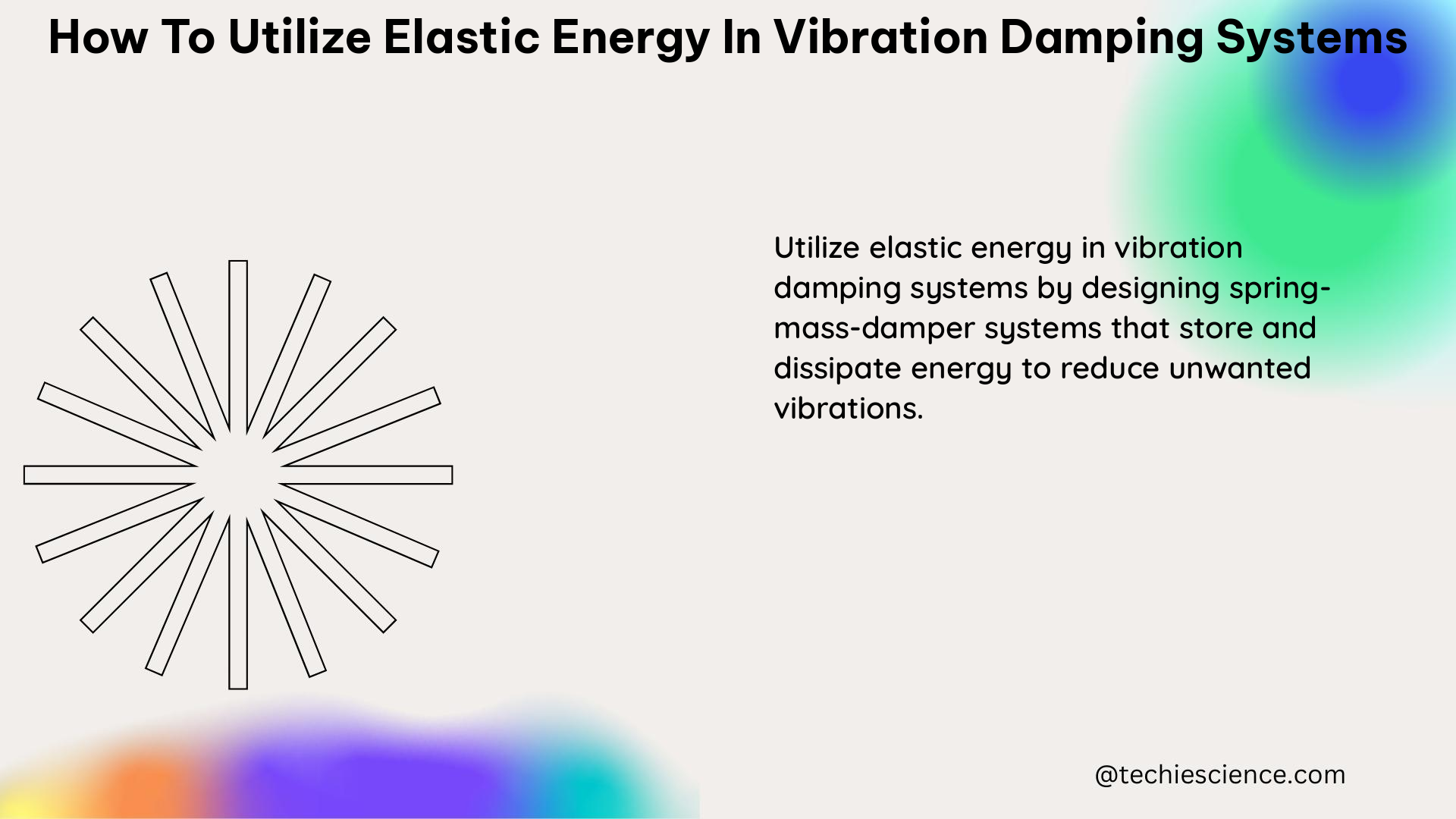Vibration damping systems play a crucial role in various engineering applications, from aerospace structures to automotive suspensions. Effectively utilizing elastic energy is a key aspect of designing efficient vibration damping systems. This comprehensive guide delves into the essential measurable and quantifiable data points that are crucial for optimizing the performance of such systems.
Damping Coefficient: The Key to Energy Dissipation
The damping coefficient, denoted as γ, is a critical parameter that determines the rate of energy dissipation in a vibration damping system. For an underdamped system, the damping coefficient must satisfy the condition γ < ω₀, where ω₀ is the natural frequency of the system.
To illustrate the importance of the damping coefficient, let’s consider a damped oscillator consisting of an elastic rubber band and a mass. In this system, the damping coefficient was experimentally measured to be γ = (0.352 ± 0.016) s⁻¹. This value provides valuable insights into the energy dissipation characteristics of the system, which is essential for designing effective vibration damping mechanisms.
Spring Constant: Quantifying Elastic Stiffness

The spring constant, denoted as k, represents the stiffness of the elastic material used in the vibration damping system. This parameter is crucial for understanding the system’s response to applied forces and displacements.
For instance, in a vibration-based technique for measuring the elastic properties of materials, the spring constant was calculated as k × l = 1.36 × 10⁶ N for a 3.51 m long, ¼” diameter, plastic-jacketed, 3 × 19 galvanized steel oceanographic cable. This information helps in the design and optimization of vibration damping systems that rely on the elastic properties of the materials used.
Damping Ratio: Characterizing the Damping Level
The damping ratio, denoted as ζ, is a dimensionless quantity that characterizes the level of damping in a vibration damping system. It provides a quantitative measure of the system’s ability to dissipate energy and control the amplitude of vibrations.
Continuing the example of the oceanographic cable, the damping ratio was found to be ζ = 0.080 ± 0.0004. This value indicates the degree of damping present in the system, which is crucial for understanding its dynamic behavior and optimizing its performance in vibration damping applications.
Loss Factor: Measuring Energy Dissipation in Viscoelastic Materials
The loss factor is a measure of the energy dissipation in viscoelastic materials, which are commonly used in vibration damping systems. This parameter is particularly important in the context of adhesively bonded joints, where the energy dissipation characteristics play a significant role in the overall performance of the system.
Researchers have developed time-based and energy-based methods to determine the loss factor of viscoelastic materials. By comparing the results obtained from these different approaches, they can gain a deeper understanding of the energy dissipation mechanisms and optimize the design of vibration damping systems.
Elastic Constants: Measuring Orthotropic Sheet Materials
For orthotropic sheet materials, a simple procedure can be used to quickly and accurately measure all four elastic constants from resonant frequency measurements. This information is crucial for designing vibration damping systems that incorporate these materials, as the elastic properties directly influence the system’s response to vibrations.
The ability to accurately measure the elastic constants of orthotropic sheet materials enables engineers to develop more efficient and reliable vibration damping solutions, tailored to the specific requirements of the application.
Viscoelastic Properties: Analyzing Damped Oscillator Behavior
The viscoelastic properties of materials, such as rubber, can be studied by analyzing the oscillations of a damped oscillator. By interpreting the experimental data using a simple model, researchers can obtain valuable information about the viscoelastic properties of the material, which is essential for designing effective vibration damping systems.
This approach allows for a deeper understanding of the energy dissipation mechanisms within the viscoelastic material, enabling the optimization of vibration damping systems that rely on the unique properties of these materials.
Conclusion
In summary, the effective utilization of elastic energy in vibration damping systems requires a comprehensive understanding of several measurable and quantifiable data points. By carefully analyzing the damping coefficient, spring constant, damping ratio, loss factor, elastic constants, and viscoelastic properties, engineers can design and optimize vibration damping systems that effectively dissipate energy and control the amplitude of vibrations.
This guide provides a detailed overview of these essential parameters and their practical applications, equipping you with the knowledge and tools necessary to harness the power of elastic energy in vibration damping systems.
References
- Peng, Z., Shi, J., Jiang, Z., & Jiang, X. (2020). Measurement of Damping Coefficient and Viscoelastic Properties of Rubber-Like Materials Using a Damped Oscillator. ACS Omega, 5(26), 16298-16305. https://pubs.acs.org/doi/10.1021/acsomega.0c01989
- Freitag, C. H., & Warnick, K. F. (2000). Vibration-Based Technique for Measuring the Elastic and Damping Constants of Orthotropic Sheet Materials. Journal of Atmospheric and Oceanic Technology, 17(5), 688-703. https://journals.ametsoc.org/view/journals/atot/17/5/1520-0426_2000_017_0688_vbtfmt_2_0_co_2.xml
- Hwang, S. F., & Chang, C. S. (2000). Determination of elastic constants of orthotropic plates using a vibration method. Composites Part B: Engineering, 31(7), 579-588. https://www.researchgate.net/publication/229315768_On_measuring_the_elastic_and_damping_constants_of_orthotropic_sheet_materials
- Adhikari, S., & Woodhouse, J. (2001). Identification of damping: Part 1, viscous damping. Journal of Sound and Vibration, 243(1), 43-61. https://www.ncbi.nlm.nih.gov/pmc/articles/PMC10007341/
- Rao, M. D. (2003). Recent applications of viscoelastic damping for noise control in automobiles and commercial airplanes. Journal of Sound and Vibration, 262(3), 457-474. https://iopscience.iop.org/article/10.1088/1402-4896/ad492d

The lambdageeks.com Core SME Team is a group of experienced subject matter experts from diverse scientific and technical fields including Physics, Chemistry, Technology,Electronics & Electrical Engineering, Automotive, Mechanical Engineering. Our team collaborates to create high-quality, well-researched articles on a wide range of science and technology topics for the lambdageeks.com website.
All Our Senior SME are having more than 7 Years of experience in the respective fields . They are either Working Industry Professionals or assocaited With different Universities. Refer Our Authors Page to get to know About our Core SMEs.